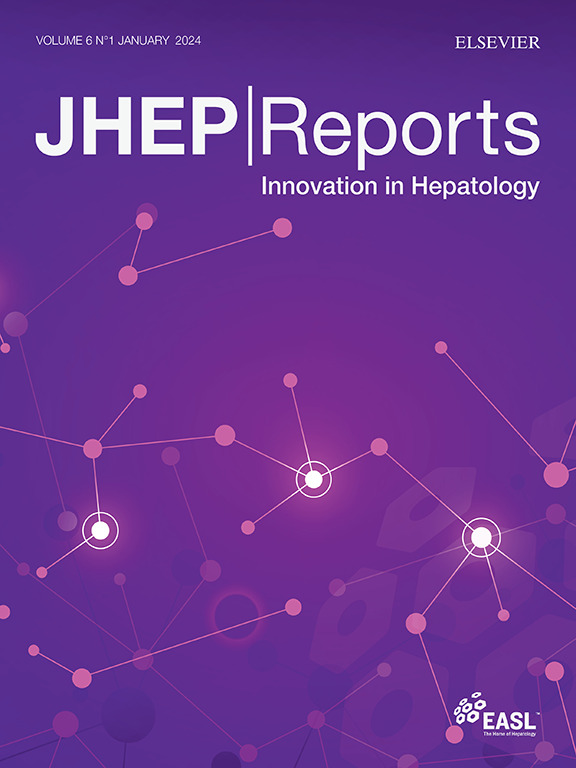Efficacy of atezolizumab plus bevacizumab for unresectable HCC: Systematic review and meta-analysis of real-world evidence
IF 7.5
1区 医学
Q1 GASTROENTEROLOGY & HEPATOLOGY
引用次数: 0
Abstract
Background & Aims
Atezolizumab plus bevacizumab (A+B) is a standard-of-care treatment in unresectable hepatocellular carcinoma (uHCC). Verification of its effectiveness outside clinical trials is an area of unmet need, especially in estimating long-term survival outcomes.
Methods
We conducted a systematic review and meta-analysis of the MEDLINE, Embase, and Cochrane libraries to evaluate therapy outcomes in patients treated with frontline A+B for uHCC outside trials. Pooled estimates of overall survival (OS) and progression-free survival (PFS) at 6 and 12 months were calculated from individual patient-level data using random-effects analysis.
Results
Of 2,179 patients selected from 12 cohorts, 80.5% were male, median age was 66 years (IQR 61.6–73.0), 61.6% had advanced-stage hepatocellular carcinoma (HCC), and 83.6% were Child–Pugh (CP) class A. Pooled 6- and 12-month OS was 82% (95% CI: 76–86%; I2 = 80%) and 65% (95% CI: 60–70%; I2 = 66%). Median OS of patients with CP-A liver function was 20.9 months (95% CI: 15.7–20.9), consistent with IMbrave150 estimates (19.2 months, 95% CI: 17.0–23.7, p = 0.58). Pooled PFS at 6 and 12 months was 57% (95% CI: 53–61%; I2 = 49%) and 35% (95% CI: 31–39%, I2 = 60%). Among patients with longer follow-up, the OS (n = 1,783) and PFS (n = 959) rates were 52% (95% CI: 46–58; I2 = 90%) and 26% (95% CI: 17–37; I2 = 91%) at 18 months, respectively. At 24 months, OS (n = 1,556) rate was 39% (95% CI: 31–49; I2 = 90%) and PFS (n = 732) rate was 25% (95% CI: 12–45; I2 = 95%).
Conclusions
The effectiveness of A+B after registration mirrors its efficacy estimates from clinical trial datasets. Long-term survival at 24 months can be achieved in up to 39% of patients with uHCC treated with A+B in routine clinical practice.
Impact and implications
This study provides real-world evidence supporting the long-term efficacy of atezolizumab plus bevacizumab (A+B) for unresectable hepatocellular carcinoma, showing survival outcomes similar to those achieved in clinical trials. These findings are important for clinicians in supporting A+B as a frontline treatment, particularly for patients with Child–Pugh class A liver function. They also offer valuable insights for policymakers and researchers for optimising treatment strategies for unresectable hepatocellular carcinoma. However, results should be interpreted with caution because of potential variability in patient populations.

阿特唑单抗联合贝伐单抗治疗不可切除HCC的疗效:真实世界证据的系统评价和荟萃分析
背景,AimsAtezolizumab +贝伐单抗(A+B)是不可切除肝细胞癌(uHCC)的标准治疗方法。在临床试验之外验证其有效性是一个未满足需求的领域,特别是在估计长期生存结果方面。方法:我们对MEDLINE、Embase和Cochrane数据库进行了系统回顾和荟萃分析,以评估一线a +B治疗原发性肝癌患者的治疗结果。6个月和12个月的总生存期(OS)和无进展生存期(PFS)的汇总估计使用随机效应分析从个体患者水平数据中计算。结果从12个队列中选择的2179例患者中,80.5%为男性,中位年龄为66岁(IQR为61.6-73.0),61.6%为晚期肝细胞癌(HCC), 83.6%为Child-Pugh (CP) a级。6个月和12个月的总OS为82% (95% CI: 76-86%;I2 = 80%)和65% (95% CI: 60-70%;I2 = 66%)。CP-A型肝功能患者的中位生存期为20.9个月(95% CI: 15.7-20.9),与IMbrave150估计值(19.2个月,95% CI: 17.0-23.7, p = 0.58)一致。6个月和12个月的合并PFS为57% (95% CI: 53-61%;I2 = 49%)和35% (95% CI: 31-39%, I2 = 60%)。在随访时间较长的患者中,OS (n = 1783)和PFS (n = 959)率为52% (95% CI: 46-58;I2 = 90%)和26% (95% CI: 17-37;I2 = 91%),分别为18个月。24个月时,OS (n = 1,556)率为39% (95% CI: 31-49;I2 = 90%), PFS (n = 732)率为25% (95% CI: 12-45;I2 = 95%)。结论注册后A+B的有效性反映了临床试验数据集的有效性估计。在常规临床实践中,接受A+B治疗的uHCC患者可达到高达39%的24个月长期生存。影响和意义本研究提供了真实世界的证据,支持atezolizumab + bevacizumab (A+B)治疗不可切除的肝细胞癌的长期疗效,显示出与临床试验相似的生存结果。这些发现对于临床医生支持A+B作为一线治疗非常重要,特别是对于Child-Pugh A级肝功能患者。它们也为决策者和研究人员优化不可切除的肝细胞癌的治疗策略提供了有价值的见解。然而,由于患者群体的潜在可变性,结果应谨慎解释。
本文章由计算机程序翻译,如有差异,请以英文原文为准。
求助全文
约1分钟内获得全文
求助全文
来源期刊

JHEP Reports
GASTROENTEROLOGY & HEPATOLOGY-
CiteScore
12.40
自引率
2.40%
发文量
161
审稿时长
36 days
期刊介绍:
JHEP Reports is an open access journal that is affiliated with the European Association for the Study of the Liver (EASL). It serves as a companion journal to the highly respected Journal of Hepatology.
The primary objective of JHEP Reports is to publish original papers and reviews that contribute to the advancement of knowledge in the field of liver diseases. The journal covers a wide range of topics, including basic, translational, and clinical research. It also focuses on global issues in hepatology, with particular emphasis on areas such as clinical trials, novel diagnostics, precision medicine and therapeutics, cancer research, cellular and molecular studies, artificial intelligence, microbiome research, epidemiology, and cutting-edge technologies.
In summary, JHEP Reports is dedicated to promoting scientific discoveries and innovations in liver diseases through the publication of high-quality research papers and reviews covering various aspects of hepatology.
 求助内容:
求助内容: 应助结果提醒方式:
应助结果提醒方式:


